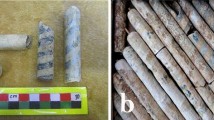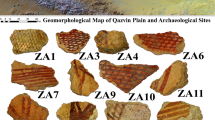Abstract
The production of glass represented an important technological achievement, and it was the starting point for the invention of a large variety of materials, produced by processes involving melting, partial or total, and precipitation of new crystalline compounds during cooling. In particular, those crystallites built-in the glaze due to partial or total insolubility of some elements originally present in the melt (for instance some colourants and opacifiers), as well as those crystallites formed in the glazes resulting from the interaction of the melt and the ceramic surface are subject of the highest interest in the study of glaze technology. Finally, devitrification and weathering gives rise to precipitation of new crystalline compounds closer to the surfaces and interfaces.
SEM-EDX and WDX have been traditionally used to obtain the chemistry of the glazes and the identification of the crystalline compounds present. However, it has some limitations identifying minute crystallites (below 0.5 micrometers) and polymorphs, which are of the highest interest in the study of historical glazes. Synchrotron Radiation micro-X-ray Diffraction has a small beam size adequate to obtain the structural information of submicron crystalline compounds and high brilliance, optimal for determining the crystallites even when present in low amounts. In addition the spatial distribution of the crystalline compounds present in the glazes fundamental for the study of the interaction between the ceramic and the glaze may be easily obtained. The identification of the microcrystallites formed in the glazes and their distribution across the glazes gives direct information on trends of the technology of production, stability and weathering of ancient glazes. In this study a collection of Islamic glazes from the 9th to the 13th century AD from different origins and obtained with different raw materials and production routes are studied. Unreacted grains, reaction compounds, crystallisations and alteration compounds as well as their space distribution are obtained.
Similar content being viewed by others
References
F.D.K. Ching, A Visual Dictionary of Architecture (Wiley, New York, 1995), p. 32
J.E. Shelby, Introduction to Glass Science and Technology (The Royal Society of Chemistry, Cambridge, 1987), p. 3
J. Molera, Evolució mineralògica i interacció de les pastes càlciques amb els vidrats de plom: implicacions arqueomètriques. Tècniques de fabricació de la ceràmica Islàmica i Mudejar, PhD thesis, University of Barcelona (1996)
M. Tite, I. Freestone, R. Mason, J. Molera, M. Vendrell, N. Wood, Lead glazes in antiquity: Methods of production and reasons for use. Archaeometry 40(2), 241–260 (1998)
J. Molera, T. Pradell, N. Salvadó, M. Vendrell-Saz, Interaction between clay bodies and lead glazes. J. Am. Ceram. Soc. 84(6), 1120–1128 (2001)
G. Artioli, I. Angelini, A. Polla, Crystals and phase transitions in protohistoric glass materials. Phase Transit. 81(2), 233–252 (2008)
T. Pradell, J. Molera, A.D. Smith, M.S. Tite, The invention of lustre: Iraq 9th and 10th centuries AD. J. Archaeol. Sci. 35, 1201–1215 (2008)
T. Pradell, J. Molera, A.D. Smith, M.S. Tite, Early Islamic lustre from Egypt, Syria and Iran (10th to 13th century AD). J. Archaeol. Sci. 35, 2649–2662 (2008)
J. Juanhuix, A. Labrador, D. Beltrán, J.F. Herranz, P. Carpentier, J. Bordas, The macromolecular crystallography station at beamline BM16 at the ESRF. Rev. Sci. Instrum. 76, 086103 (2005)
V. Porter, O. Watson, ‘Tell Minis’ wares, in Syria and Iran: Three Studies in Medieval Ceramics, ed. by J. Allan, C. Roberts. Oxford Studies in Islamic Art, vol. IV (Oxford University Press, Oxford, 1987), pp. 175–256
J.M. Fernández Navarro, El vidrio, Consejo Superior de Investigaciones Científicas, Fundación Centro Nacional del Vidrio, Madrid, España (2003)
T. Tarvornpanich, G.P. Souza, W.E. Lee, Microstructural evolution on firing soda-lime-silica glass fluxed whitewares. J. Am. Ceram. Soc. 88(5), 1302–1308 (2005)
T. Tarvornpanich, G.P. Souza, W.E. Lee, Microstructural evolution in clay-based ceramics, I: single-components and binary mixtures of clay, flux, and quartz filler. J. Am. Ceram. Soc. 91(7), 2264–2271 (2008)
T. Tarvornpanich, G.P. Souza, W.E. Lee, Microstructural evolution in clay-based ceramics, II: ternary and quaternary mixtures of clay, flux, and quartz filler. J. Am. Ceram. Soc. 91(7), 2272–2280 (2008)
O. Watson, Persian Lustre Ware. The Faber Monographs on Pottery and Porcelain Faber and Faber (Watson, London, 1985)
J.W. Allan, Abuül-Qas̈im’s, Treatise on Ceramics, Iran IX, 111–120 (1973)
C. Doneda, H.G. Riella, Aquisition and characterization of nepheline glass-ceramics. Ciênc. Tecnol. Araraquara 15(8), 65–72 (2000)
A.M. Keblow, Bernsted. Early Islamic Pottery. Materials and Techniques (Archetype Publications, London, 2003)
J. Molera, T. Pradell, N. Salvadó, M. Vendrell Saz, Evidence of tin oxide recrystallization in opacified lead glazes. J. Am. Ceram. Soc. 82(10), 2871–2875 (1999)
H. Li, P. Hrma, J.D. Vienna, M. Qian, Y. Su, D.E. Smith, Effects of Al2O3, B2O3, Na2O, and SiO2 on nepheline formation in borosilicate glasses: chemical and physical correlations. J. Non-Cryst. Solids 331(1), 202–216 (2003)
A. Caiger-Smith, Lustre Pottery (New Amsterdam Books, New York, 1991)
R.B. Mason, Shine like the Sun. Lustre-painted and associated pottery from the Medieval Middle East, in Bibliotheca Iranica. Islamic Art and Architecture Series, vol. 12 (Mazda Publishers, Costa Mesa, 2004)
H. Philon, Early Islamic Ceramics (Benaki Museum, Athens, 1980)
J. Buxeda, H. Mommsen, A. Tsolakidou, Alterations of Na-, K- and Rb- concentrations in Mycenaean pottery and a proposed explanation using X-ray diffraction. Archaeometry 44(2), 1–12 (2002)
A. Schwedt, H. Mommsen, N. Zacharias, J. Buxeda, Analcime crystallization and compositional profiles—comparing approaches to detect post-depositional alterations in archaeological pottery. Archaeometry 48(2), 237–251 (2006)
J. Molera, T. Pradell, J. Farjas, X. Alberch, J. Burch, M. Sureda, La cerámica dorada del mas Llorens de Salt. in Avances en Arqueometría 2005. Actas del VI Congreso Ibérico de Arqueometría, 2005. pp. 102–120 (2007)
J. Molera, T. Pradell, S. Martínez-Manent, M. Vendrell-Saz, The growth of sanidine crystals in the lead glazes of hispano-moresque pottery. Appl. Clay Sci. 7, 483–491 (1993)
C.N. Fenner, The stability relations of the silica minerals. Am. J. Sci. 36, 331–384 (1913)
S.J. Stevens, R.J. Hand, J.H. Sharp, Polymorphism of silica. J. Mater. Sci. 32, 2929–2935 (1997)
G. Baldi, E. Generali, C. Leonelli, T. Manfredini, G.C. Pellacani, C. Siligardi, Effects of nucleating agents on diopside crystallization in new glass-ceramics for tile-glaze application. J. Mater. Sci. 30, 3251–3255 (1995)
E.M.A. Hamzawy, E.A.M. El-Meliegy, Preparation of nepheline glass–ceramics for dental applications. Mater. Chem. Phys. 112(2), 432–435 (2008)
G.H. Beall, J.E. Pierson, Method of making peraluminous nepheline/kalsilite glass-ceramics. Int. CI.3 C03B 27/02. Pat. n. 4, pp. 341–544. 31 out. 1980: 27 jul. (1982)
Author information
Authors and Affiliations
Corresponding author
Rights and permissions
About this article
Cite this article
Pradell, T., Molera, J., Salvadó, N. et al. Synchrotron radiation micro-XRD in the study of glaze technology. Appl. Phys. A 99, 407–417 (2010). https://doi.org/10.1007/s00339-010-5639-7
Received:
Accepted:
Published:
Issue Date:
DOI: https://doi.org/10.1007/s00339-010-5639-7




